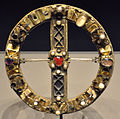Glen Lyon


Glen Lyon is a glen in Perthshire, through which runs the River Lyon. It is the longest enclosed glen in the Highlands and runs for 34 miles from Loch Lyon in the west to the village of Fortingall in the east.
This glen is known in Gaelic as Gleann Lìomhann but also as "An Crom Ghleann" (the bent glen). The land given over to the MacGregors was An Tòiseachd.
Loch Lyon, a dammed loch creating a vast reservoir, lies in the very west of the county and the River Lyon emerges below the dam to flow eastwards. I minor road follows the glen down from the foot of the loch, past several ancient and historical sites, through no villages but scattered farmsteads. A couple of outdoor activity centres sit in the glen, as at Bridge of Blagie.
The glen alternately spreads and narrows. It emerges from a particular narrow defile by the Tay Forest Park at Fortingall, where Glenlyon House stands, and a hotel. Below this point the last stretch of the glen is more inhabited, down to the Appin of Dull where it joins the River Tay
History
Quite densely inhabited from prehistoric times (as many archaeological sites attest), though its present population is of modest size, the glen has been home to many families, including MacGregors, Menzies, Stewarts, Macnaughtans, MacGibbons and the Campbells of Glen Lyon. One of this family, Robert Campbell of Glenlyon (1630–1696), led the detachment of government troops responsible for the infamous Glencoe Massacre, of the MacDonalds of Glencoe in 1691.

A magnificent silver-gilt brooch set with precious stones belonging to the Campbells of Glen Lyon (that has been dated to the early 16th century) is in the collection of the British Museum.[1]
Glen Lyon, also written Glenlyon, has been the home of (among others) early Christian monks (including Adomnán, locally called Eonán, who died in 704), Abbot of Iona and biographer of St Columba), warriors, literary figures, explorers, castles (of which Meggernie Castle is still inhabited and Carnbaan lies ruined) and arguably the best cattle in the Highlands. Its history is described in Alexander Stewart's A Highland Parish (1928), and Duncan Campbell's The Lairds of Glenlyon (1886).
Book of Lismore
James MacGregor, parish priest of Fortingall in the early 16th century, compiled the Book of the Dean of Lismore, the most important surviving collection of mediæval Scottish Gaelic poetry. His Chronicle, covering local events in a mixture of Scots and Latin, is also extant, and is an important historical source for the central Highlands.
See also
Pictures
-
River Lyon
-
Glen Lyon from Bridge of Balgie
-
Cattle in Glen Lyon
| ("Wikimedia Commons" has material about Glen Lyon) |
References
- Location map: 56°35’38"N, 4°18’11"W


